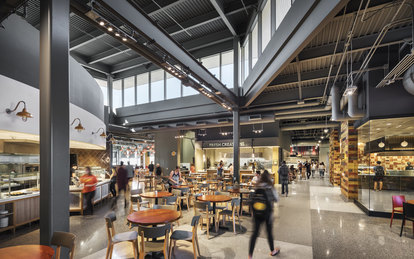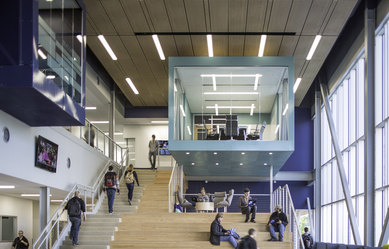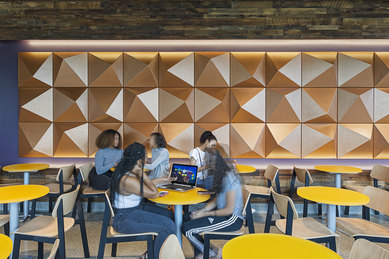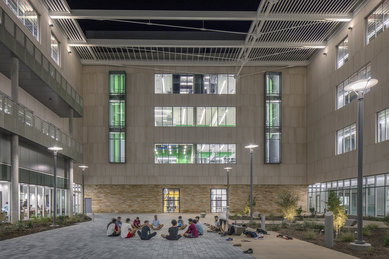Designing for the Next Generation of Student Life: Part 2 - Digitally and Socially Connected

Western Michigan University Valley Dining Commons / Serves as a student center with places for students to study, socialize and relax.
We can all appreciate the incredible potential of the digital age. Technology has put vast amounts of information at our fingertips and helped level the playing field for personal and intellectual investigation. At the same time, the digital world presents many serious challenges for Generation Z. The internet and social media, while powerful tools to connect people and ideas, have also shown signs of being highly time-consuming, impersonal, and in some cases, detrimental to self-esteem. In iGen, Dr. Jean Twenge uses empirical data to demonstrate a sharp rise in depression and loneliness correlated to dramatically increased screen time among young people. Despite real concerns about the impact of social media on Generation Z, technology is ever-present and essential to a student’s long-term success. Clients have shared that today’s students bring an average of three digital devices to campus and expect digital connections to be completely seamless. In this environment, student life spaces will need to enable students to strike a healthy balance between tech-enabled learning and in-person social connections.
One approach is to use technology as part of the solution in achieving balance. Take, for example, how technology is encouraging personal connections and student success through the gamification of student life at the Peter T. Paul College of Business and Economics at the University of New Hampshire. The First-year Innovation and Research Experience (FIRE) is a unique program that provides a “game-like experience, guided by alumni and peer mentors for first-year students to engage in developing habits and strategies for success.”[1] The program is meant to enhance a first-year student’s interpersonal development and transition to college by awarding points to team members when they take part in campus activities. An accompanying year-long seminar course serves to reinforce the student’s collaboration and communication skills. The innovative program partners gaming (a prevalent part of Generation Z’s childhood) with supportive freshmen seminars, which provides the platform for students to socialize and develop valuable, real-world skills.
Another way universities are helping students broaden their in-person social networks is by encouraging connections between the campus, outside researchers and the surrounding community. Co-working and community collaboration spaces have the potential to become important new components in mixed-use student life facilities. These spaces could help create a crosscurrent of dialogue between academic and professional pursuits, between students and employers, and between the community and campus. After WeWork opened their first on-campus location at the University of Maryland in December 2018, it raised questions for many universities: Could co-working start to address the real estate challenge of administrative and faculty office space on campus? Could co-working help establish partnerships between local industry and universities? Could these spaces be tuned to encourage more specific kinds of collaboration? What we do know is that as student life spaces continue to evolve from dedicated to mixed uses, students will have increased opportunities to connect with each other as well as a wealth of diverse on- and off-campus partners.

Dakota State University Beacom Institute of Technology / Study spaces are tucked throughout the building, giving students ample opportunities to connect and collaborate.
In addition to connecting to the surrounding community, student life projects are being designed to help students connect more frequently and meaningfully with their peers. Today’s students want a lively, “see and be seen” atmosphere that offers a whole host of student services in one place. We are responding by co-locating amenities and increasing opportunities for chance encounters. Instead of a single utilitarian laundry room in the basement of the residence hall, we are planning smaller laundry rooms on every residential floor, near the lounge and study spaces. Not only does this strategy make the students happier because they don’t have to cart their laundry downstairs, but it keeps them close to other active spaces. Another example of this approach is our Valley Dining Center project at Western Michigan University, which houses multiple restaurant-quality dining venues, a convenience store, study and lounge areas, all under one roof. It’s this variety of amenities that makes the Center feel like a central town square, a place you can stay all day because it has so many different offerings. The Student Union used to be the one place on campus you were sure to see someone you know or meet someone new, but these new centers of student activity are distributing that social connection across campus.
Western Michigan University Valley Dining Center / A variety of seating environments offer students a choice of places to connect.
In contrast to the image of a constantly plugged-in digital native, tomorrow’s higher education students are also looking for places to unplug. Many campuses, such as Middlebury College, are sponsoring informal campaigns for students to do a “digital detox” and opt out of social media for a day, week, or month. By creating zones free from digital distraction, student life spaces may help students increase personal interactions and physical recreation, and possibly decrease stress levels. For a recent Sports and Recreation Master Plan at Ohio State University, we balanced the focus on traditional recreation fields with an emphasis on ‘informal, unprogrammed recreation’ by including areas for picnicking, gardening, slacklining, and corn hole to name a few. This informal play isn’t as much about competition as it is about having fun, getting outside and connecting with others. In addition to informal recreation opportunities, we are seeing an increasing interest in other technology-free zones like outdoor meditation spaces, community gardens, and interactive art installations that will help students disconnect, decompress and reconnect with the world around them.
University of Texas at Dallas Engineering Building / Yoga classes are held in the outdoor courtyard of the University of Texas at Dallas Engineering Building.
We know that for tomorrow’s students, digital and social connection are not necessarily at odds with one another, but it is difficult for many students to find balance. Today’s students are immersed in the digital world for several hours a day, potentially to the detriment of their social and long-term success. As designers, we are seeking ways to balance this depth of digital connectivity with the breadth and variety of social experience, creating well-rounded, happy young adults. Therefore, the next generation of student life spaces must be thoughtfully designed to reinforce the social, relaxing and experiential opportunities on campus.
[1] “FIRE: First-year Innovation and Research Experience” University of New Hampshire. Website: https://paulcollege.unh.edu/experience/fire-first-year-innovation-research-experience

